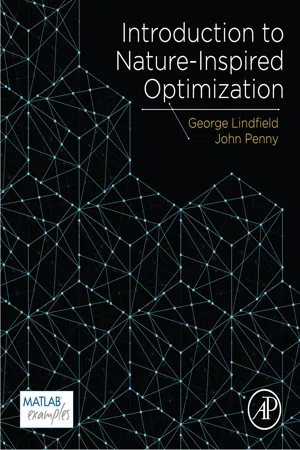
- 256 pages
- English
- ePUB (mobile friendly)
- Available on iOS & Android
Introduction to Nature-Inspired Optimization
About This Book
Introduction to Nature-Inspired Optimization brings together many of the innovative mathematical methods for non-linear optimization that have their origins in the way various species behave in order to optimize their chances of survival. The book describes each method, examines their strengths and weaknesses, and where appropriate, provides the MATLAB code to give practical insight into the detailed structure of these methods and how they work.
Nature-inspired algorithms emulate processes that are found in the natural world, spurring interest for optimization. Lindfield/Penny provide concise coverage to all the major algorithms, including genetic algorithms, artificial bee colony algorithms, ant colony optimization and the cuckoo search algorithm, among others. This book provides a quick reference to practicing engineers, researchers and graduate students who work in the field of optimization.
- Applies concepts in nature and biology to develop new algorithms for nonlinear optimization
- Offers working MATLAB® programs for the major algorithms described, applying them to a range of problems
- Provides useful comparative studies of the algorithms, highlighting their strengths and weaknesses
- Discusses the current state-of-the-field and indicates possible areas of future development
Frequently asked questions
Information
An Introduction to Optimization
Abstract
Keywords
1.1 Introduction
1.2 Classes of Optimization Problems
Table of contents
- Cover image
- Title page
- Table of Contents
- Copyright
- Dedication
- About the Authors
- Preface
- Acknowledgment
- Notation
- Chapter 1: An Introduction to Optimization
- Chapter 2: Evolutionary Algorithms
- Chapter 3: Particle Swarm Optimization Algorithms
- Chapter 4: The Cuckoo Search Algorithm
- Chapter 5: The Firefly Algorithm
- Chapter 6: Bacterial Foraging Inspired Algorithm
- Chapter 7: Artificial Bee and Ant Colony Optimization
- Chapter 8: Physics Inspired Optimization Algorithms
- Chapter 9: Integer, Constrained and Multi-Objective Optimization
- Chapter 10: Recent Developments and Comparative Studies
- Appendix A: Test Functions
- Appendix B: Program Listings
- Solutions to Problems
- References
- Index